Mises, Ludwig von. Human Action: A Treatise on Economics
Подождите немного. Документ загружается.

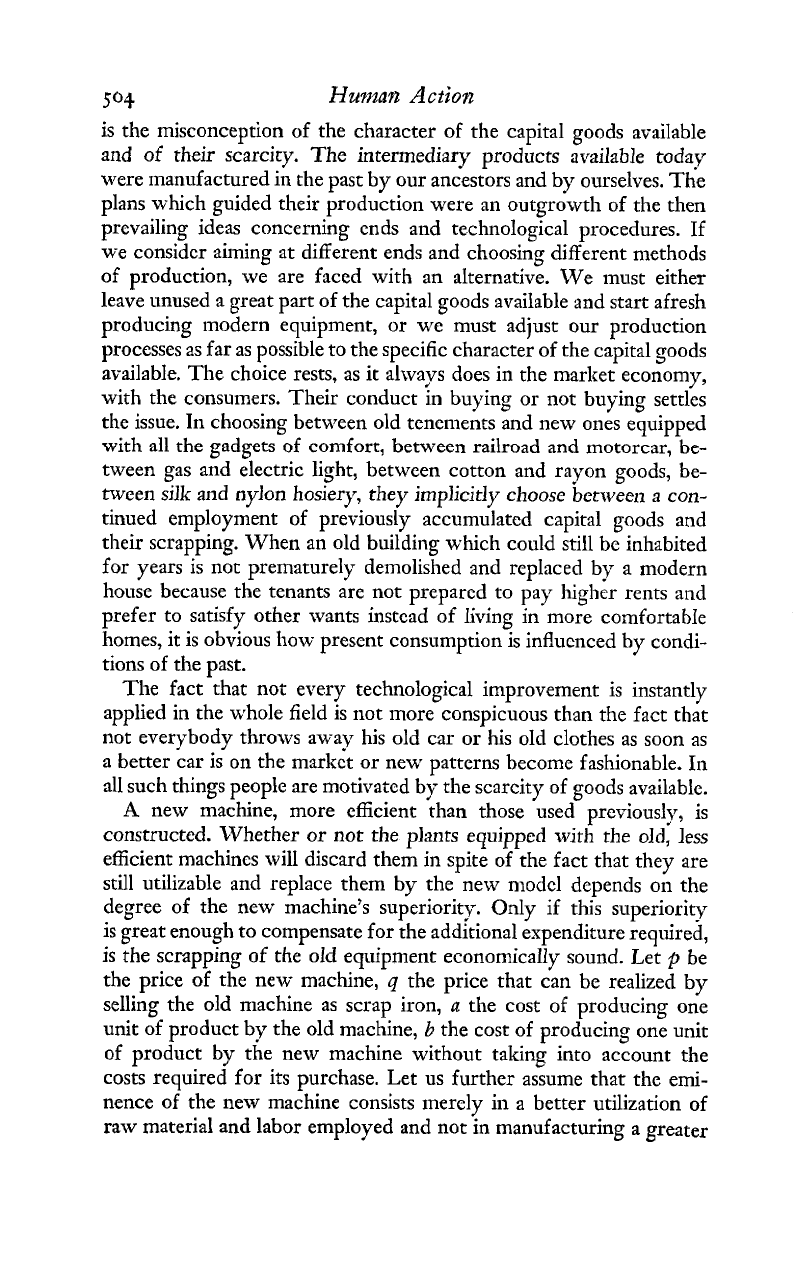
5%
Human
Action
is the misconception of the character of the capital goods available
and of their scarcity. The intermediary products available today
were manufactured in the past by our ancestors and by ourselves. ~ce
plans which guided their production were an outgrowth of the then
prcvailing ideas concerning cnds and technological procedures. If
w-e consider aiming at different ends and choosing different methods
of production, we are faced with an alternative. We must either
leave unused a great part of the capital goods available and start afresh
producing modern equipment, or we must adjust our production
processes as far as possible to the specific character of the capital goods
available. The choice rests, as it always does in the market economy,
with the consumers. Their conduct in buying or not buying settles
the issue. In choosing between old
tenements
and new ones equipped
with all the gadgets
of
comfort, between railroad and motorcar, be-
tween gas and electric light, between cotton and rayon goods, be-
tween silk and nylon hosiery, they implicitly choose between
a
con-
tinued employment of previously accumulated capital goods and
their scrapping. When an old building which could still be inhabited
for years is not prematurely demolished and replaced by a modern
house because the tenants are not preparcd to
pay
high& rents and
prefer to satisfy other wants instcad of living in more comfortabIe
homes, it is obvious how prescnt consumption is influcnced by condi-
tions of the past.
The fact that not every technological improvement is instantly
applied in the whole field is not more conspicuous than the fact that
not everybody throws away his old car or his old clothes as soon as
a better car is on the marlrct or new patterns become fashionable. In
all such things people are motivatcd by the scarcity of goods available.
A
new machine, more efficient than those used previously, is
constructed. Whether
or
not the plants equipped
with
the old, less
efficient machincs will discard them in spite of
the
fact that they are
still utilizable and replace them by the new nlodcl depends on the
degree of the new machine's superiority. Only if this superioriw
is
great enough to compensate for the additional expenditure required,
is the scrapping of the old equipment economically sound. Let
p
be
the price of the new machine,
q
the price that can be realized by
selling the old machine as scrap iron,
a
the cost of producing one
unit of product by the old machine,
b
the cost of producing one unit
of product
by
the new machine without taking into account the
costs required for its purchase. Let us further assume that the emi-
nence of the new machine consists rnercly
in
a better utilization of
raw material and labor employed and not in manufacturing a greater
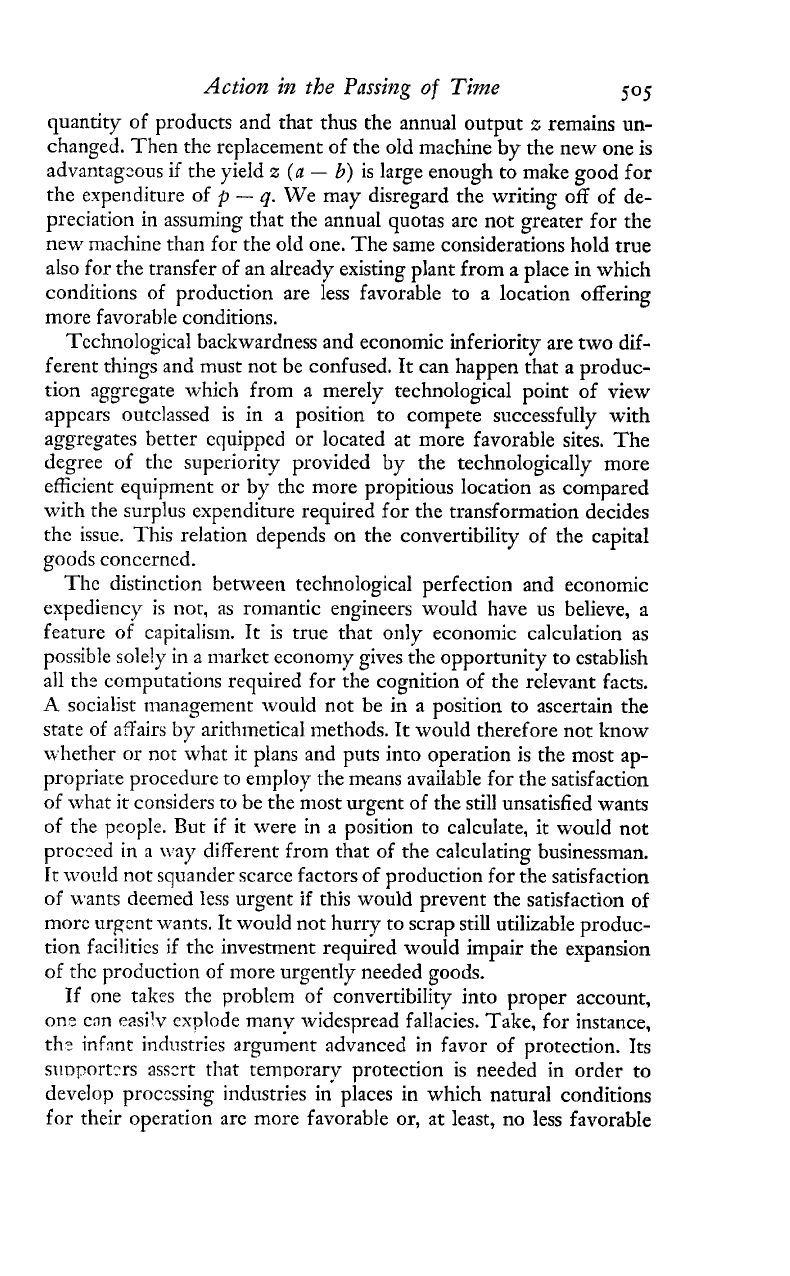
Action in the Passing
of
Time
505
quantity of products and that thus the annual output
z
remains un-
changed. Then the replacement of the old machine by the new one is
advantagzous if the yield
z
(a
-
b)
is large enough to make good for
the expenditure of
p
-
q.
We may disregard the writing off of de-
preciation in assuming that the annual quotas arc not greater for the
new machine than for the old one. The same considerations hold true
also for the transfer of an already existing plant from a place in which
conditions of production are less favorable to a location offering
more favorable conditions.
Technological backwardness and economic inferiority are two dif-
ferent things and must not be confused. It can happen that a produc-
tion aggregate w-hich from a merely technological point of view
appears outclassed is in a position to compete successfully with
aggregates better equipped or located at more favorable sites. The
degree of the superiority provided by the technologically more
efficient equipment or by the more propitious location as compared
with the surplus expenditure required for the transformation decides
the issue. This relation depends on the convertibility of the capital
goods concerned.
The distinction between technological perfection and economic
expediency is not, as romantic engineers would have us believe,
a
feature of capitalism. It is true that only economic calculation as
possible solely in
a
market economy gives the opportunity to establish
all th: computations required for the cognition of the relevant facts.
A
socialist nlanagement .would not be in a position to ascertain the
state of affairs by arithmetical methods. It would therefore not know
xvhetlier or not what it plans and puts into operation is the most ap-
propriate procedure to employ the means available for the satisfaction
of what
it
considers to be the kost urgent of the still unsatisfied wants
of the people. But
if
it were in a position to calculate, it would not
proceed
in
a
way difFerent from that of the calculating businessman.
It would not squander scarce factors of production for the satisfaction
of wants deemed iess urgent if this wouid prevent the satisfaction of
morc urgent wants. It would not hurry to scrap still utilizable produc-
tion
facilities
if thc investment required would impair the expansion
of thc production of more urgently needed goods.
If one takrs the problem of convertibility into proper account,
on: cnn easilv explode manv widespread fallacies. Take, for instance,
th; infnnt
industries
argument advanced in favor of protection. Its
s~lnportm
assert
that temporary protection is needed in order to
develop proccssing industries in places in which natural conditions
for their operation are more favorable or, at least, no less favorable
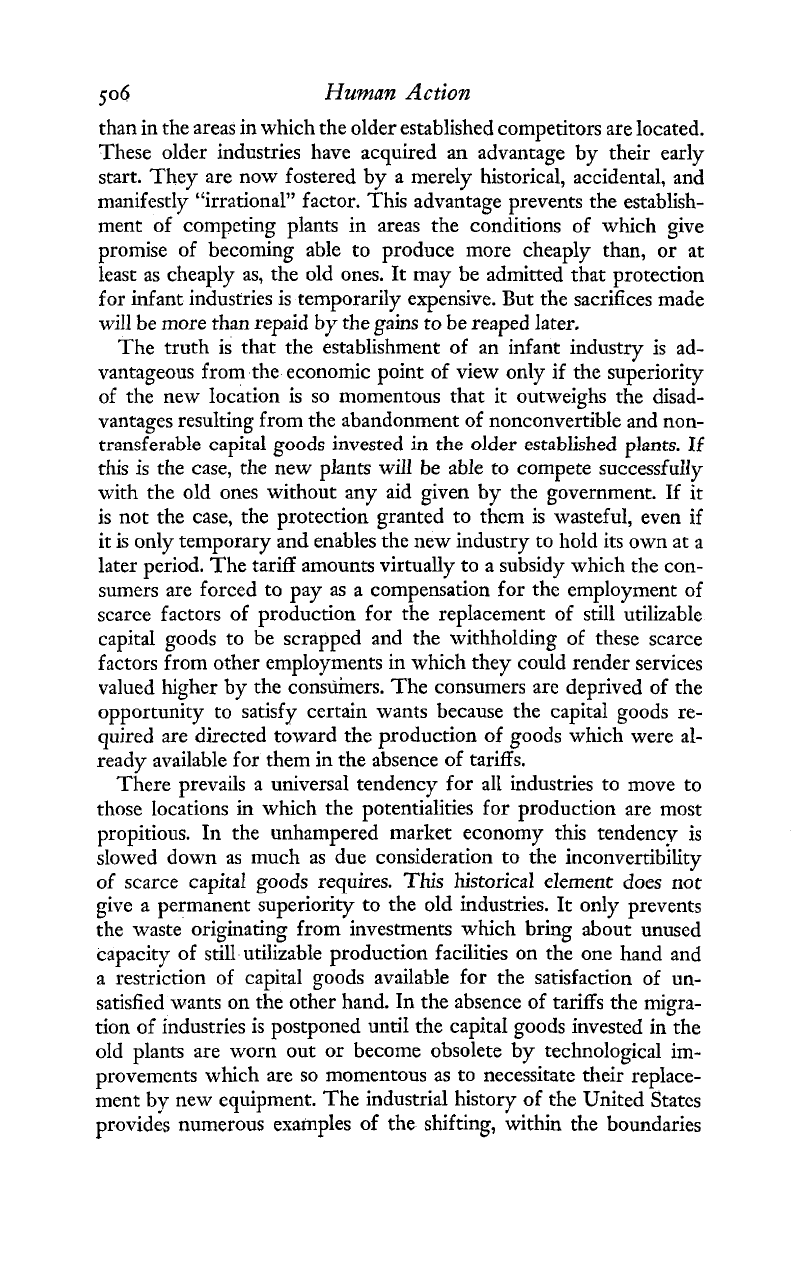
506
Human
Action
than in the areas in which the older established competitors are located.
These older industries have acquired an advantage by their early
start. They are now fostered by a merely historical, accidental, and
manifestly "irrational" factor. This advantage prevents the establish-
ment of competing plants in areas the conditions of which give
promise of becoming able to produce more cheaply than, or at
least as cheaply as, the old ones. It may be admitted that protection
for infant industries is temporarily expensive. But the sacrifices made
will be more than repaid by the gains to be reaped later.
The truth is that the establishment of an infant industry is ad-
vantageous from the economic point of view only if the superiority
of the new location is so momentous that it outweighs the disad-
vantages resulting from the abandonment of nonconvertible and non-
transferable capital goods invested in the older established plants.
If
this is the case, the new plants will be able to compete successfully
with the old ones without any aid given by the government. If it
is not the case, the protection granted to thcm
is
wasteful, even if
it is only temporary and enables the new industry to hold its own at a
later period. The tariff amounts virtually to a subsidy which the con-
sumers are forced to pay as a compensation for the employment of
scarce factors of production for the replacement of still
utilizable
capital goods to be scrapped and the withholding of these scarce
factors from other employments in which they could render services
valued higher by the consumers. The consumers are deprived of the
opportunity to satisfy certain wants because the capital goods re-
quired are directed toward the production of goods which were al-
ready available for them in the absence of tariffs.
There prevails a universal tendency for all industries to move to
those locations in which the potentialities for production are most
propitious. In the unhampered market economy this tendencv is
slowed down as much as due consideration to the inconvertibkty
of scarce capital goods requires. This historical element does not
give a permanent superiority to the old industries.
It
only prevents
the waste originating from investments which bring about unused
capacity of still utilizable production facilities on the one hand and
a restriction of capital goods available for the satisfaction of un-
satisfied wants on the other hand. In the absence of tariffs the migra-
tion of industries is postponed until the capita1 goods investcd in the
old plants are worn out or become obsolete by technological im-
provements which are so momentous as to necessitate their replace-
ment
by
new equipment. The industrial history of the United States
povidls numerous examples of the shifting, within the boundaries
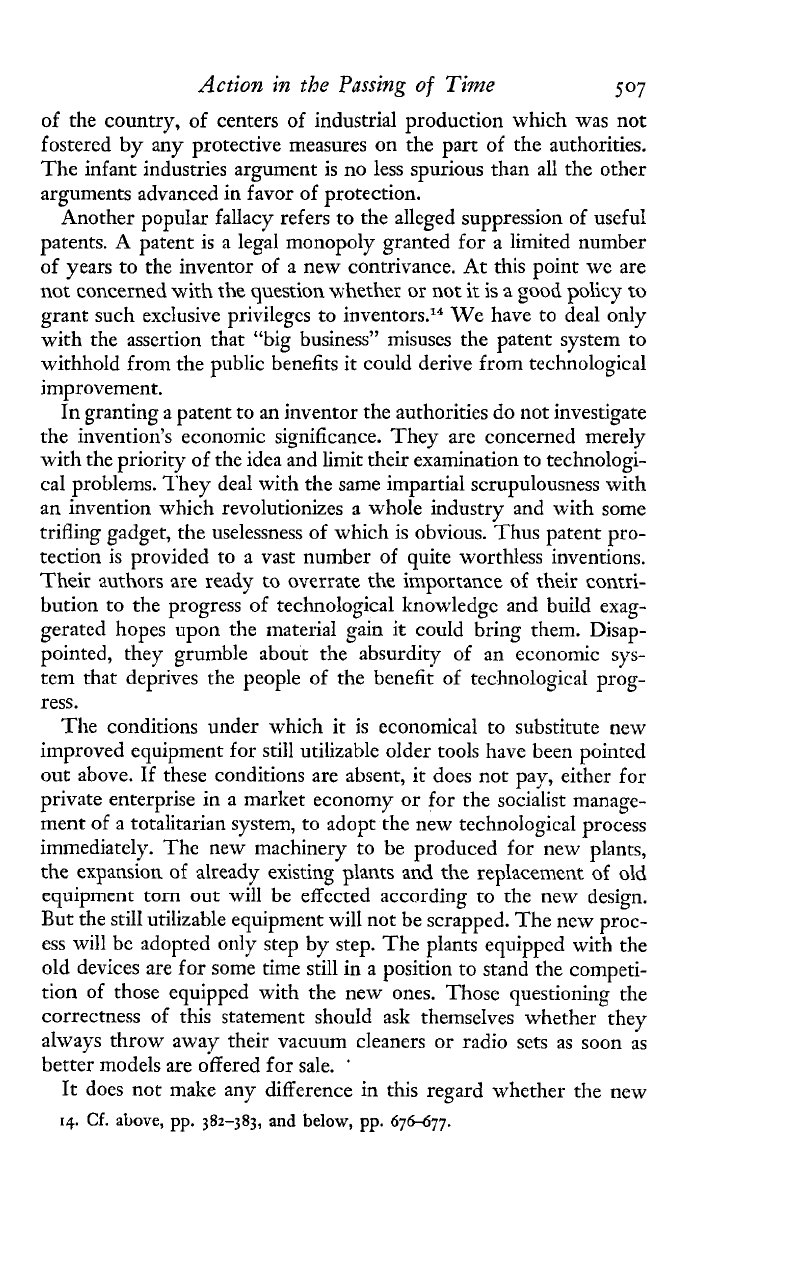
Action in the Passing
of
Time
507
of the country, of centers of industrial production which was not
fostered by any protective measures on the part of the authorities.
The infant industries argument is no less spurious than all the other
arguments advanced in favor of protection.
Another popuIar fallacy refers to the alleged suppression of useful
patents.
A
patent is a legal monopoly granted for a limited number
of years to the inventor of a new contrivance. At this point we are
not concerned with the question whether or not
it
is
a
good policy to
grant such exclusive privileges to inventors.14 We have to deal only
with the assertion that "big business" misuses the patent system to
withhold from the public benefits it could derive from technological
improvement.
In granting a patent to an inventor the authorities do not investigate
the invention's economic significance. They are concerned merely
with the priority of the idea and limit their examination to technologi-
cal problems. They deal with the same impartial scrupulousness with
an invention which revolutionizes a whole industry and with some
trifling gadget, the uselessness of which is obvious. Thus patent pro-
tection is provided to a vast number of quite worthless inventions.
Their authors are ready to overrate the importance of their contri-
bution to the progress of technological knowledge and build exag-
gerated hopes upon the material gain it could bring them. Disap-
pointed, they grumble about the absurdity of an economic sys-
tem that deprives the people of the benefi; of technological prog-
ress.
The conditions under which it is economical to substitute new
i~nproved equipment for still utilizable older tools have been pointed
out above. If these conditions are absent, it does not pay, either for
private enterprise in a market economy or for the socialist manage-
ment of a totalitarian system, to adopt the new technological process
immediately. The new machinery to be produced for new plants,
the expansion of already existing
plants
and the replacement of old
equipment torn out will be effected according to the new design.
But the still utilizable equipment will not be scrapped. The new proc-
ess will bc adopted only step by step. The plants equipped with the
old devices are for some time still in a position to stand the competi-
tion of those equippcd with the new ones. Those questioning the
correctness of this statement should ask themselves whether they
always throw away their vacuum cleaners or radio sets as soon as
better models are offered for sale.
'
It does not make any difference in this regard whether the new
14.
Cf.
above,
pp.
382-383,
and below,
pp.
676677.

508
Human
Action
invention is or is not protected by a patent.
A
firm that has acquired
a
license has already expended money for the new invention.
If
it
nonetheless does not adopt the new method, the reason is that its
adoption does not pay. It is of no avail that the government-created
nlonopoly which the patent provides prevents competitors from
applying it. What counts alone is the degree of superiority secured
by the new invention as against old methods. Superiority means re-
duction in the cost of production per unit or such an improvement
in the quality of the product that buyers are ready to pay adequately
higher prices. The absence of a sufficient degree of superioritv to
make the cost of transformation profitable is proof of the fact-that
consumers are more intent upon acquiring other goods than upon en-
joying the benefits of the new invention. It is the consumers with
whom the ultimate decision rests.
Superficial observers sometimes fail to see these facts because they
are deluded by the practice of many big enterprises of acquiring the
rights granted by a patent in their field regardIess of its usefulness.
This practice stems from various considerations:
I.
The economic significance of the innovation is not yet recog-
nizable.
z.
The innovation is obviously useless. But the firm beIieves that it
could develop it in such a way as to make it useful.
3.
The immediate application of the innovation does not pay. But
the firm intends to apply
it
later when replacing its worn-out equip-
ment.
4.
The firm wants to encourage the inventor to continue his re-
search in spite of the fact that up to now his endeavors have not re-
sulted in a practically utilizable innovation.
j.
The firm wants to placate litigious inventors in order to spare
the money, time, and nervous strain which frivolous infringement
suits bring about.
6.
The firm resorts to hardly disguised bribery or yields to veiled
3.
o~ackmaii when paying for quite usciess patents to oficers, engineers,
or other influential personnel of firnis or institutions which are its
customers or potential customers.
If an invention is so superior to the old processes that it makes the
old equipment obsolete and peremptorily demands its immediate re-
placement by new machines, the transformation will be effected no
matter whether the privilege conferred by the patcnt is in the hands
of the owners of the old equipmeht or of an independent firm. The
assertions to the contrary are based on the assumption that not only
the inventor and his attorneys but aIso all people already active
in
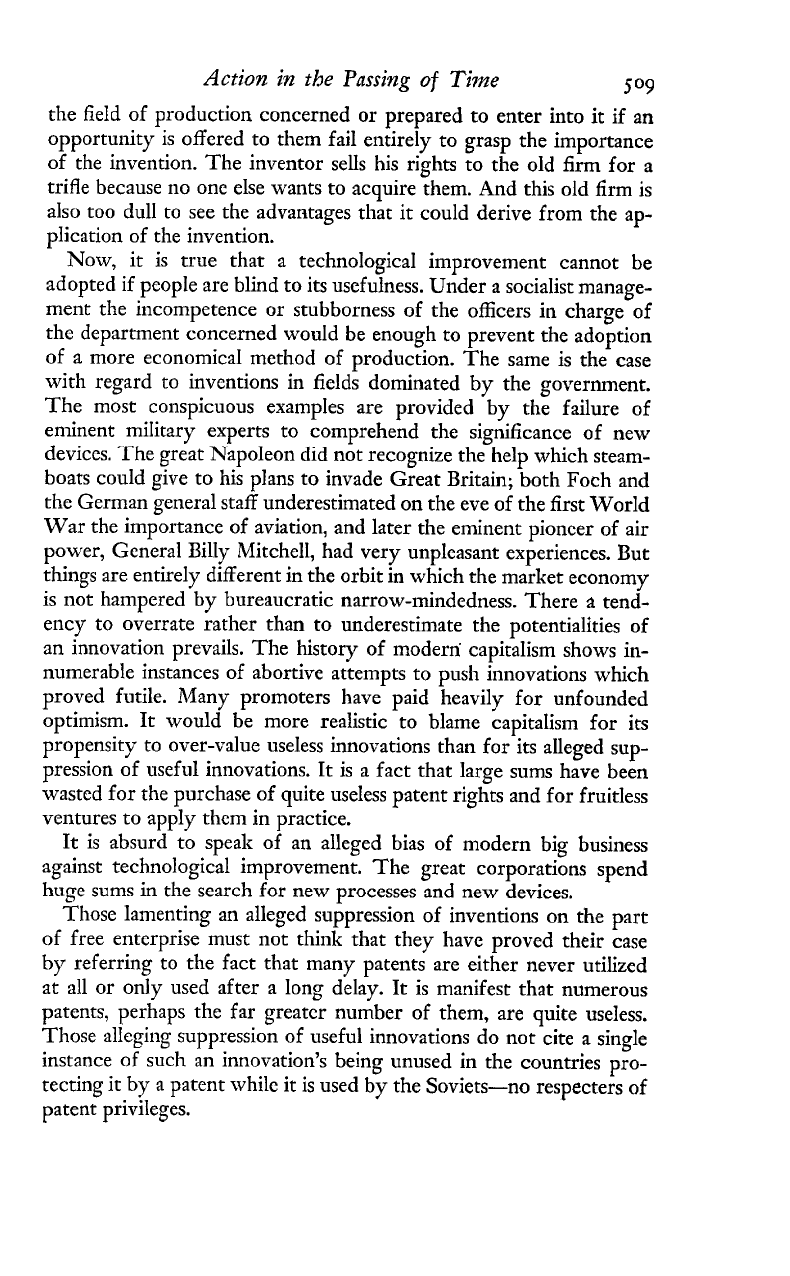
Action in the
Passing
of Time
509
the field of production concerned or prepared to enter into it if an
opportunity is offered to them fail entirely to grasp the importance
of the invention. The inventor sells his rights to the old firm for a
trifle because no one else wants to acquire them. And this old firm is
also too dull to see the advantages that it could derive from the ap-
plication of the invention.
Now, it is true that a technological improvement cannot be
adopted if people are blind to its usefulness. Under a socialist manage-
ment the incompetence or stubborness of the officers in charge of
the department concerned would be enough to prevent the adoption
of a more economical method of production. The same is the case
with regard to inventions in fields dominated by the government.
The most conspicuous examples are provided by the failure of
eminent military experts to comprehend the significance of new
devices. The great Napoleon did not recognize the help which steam-
boats could give to his plans to invade Great Britain; both Foch and
the German general staff underestimated on the eve of the first World
War the importance of aviation, and later the eminent pioneer of air
power, General Billy Mitchell, had very unpleasant experiences. But
things are entirely different in the orbit in which the market economy
is not hampered by bureaucratic narrow-mindedness. There
a
tend-
ency to overrate rather than to underestimate the potentialities of
an innovation prevails. The history of modern capitalism shows in-
numerable instances of abortive attempts to push innovations which
proved futile. Many promoters have paid heavily for unfounded
optimism.
It
would be more realistic to blame capitalism for its
propensity to over-value useless innovations than for its alleged sup-
pression of useful innovations.
It
is a fact that large sums have been
wasted for the purchase of quite useless patent rights and for fruitless
ventures to apply them in practice.
It is absurd to speak of an alleged bias of modern big business
against technological improvement. The great corporations spend
hrirrp
PIT-S
the
sCzr&
for
~ew
processes
afid
fie.,t.
devices.
---a-
---
Those lamenting an alleged suppression of inventions on the part
of free enterprise must not think that they have proved their case
by
referring to the fact that many patents are either never utilized
at all or only used after a long delay. It is manifest that numerous
patents, perhaps the far greater number of them, are quite useless.
Those alleging suppression of useful innovations do not cite a single
instance of such an innovation's being unused in the countries pro-
tecting it
by
a patent while it is used by the Soviets-no respecters
of
patent privileges.
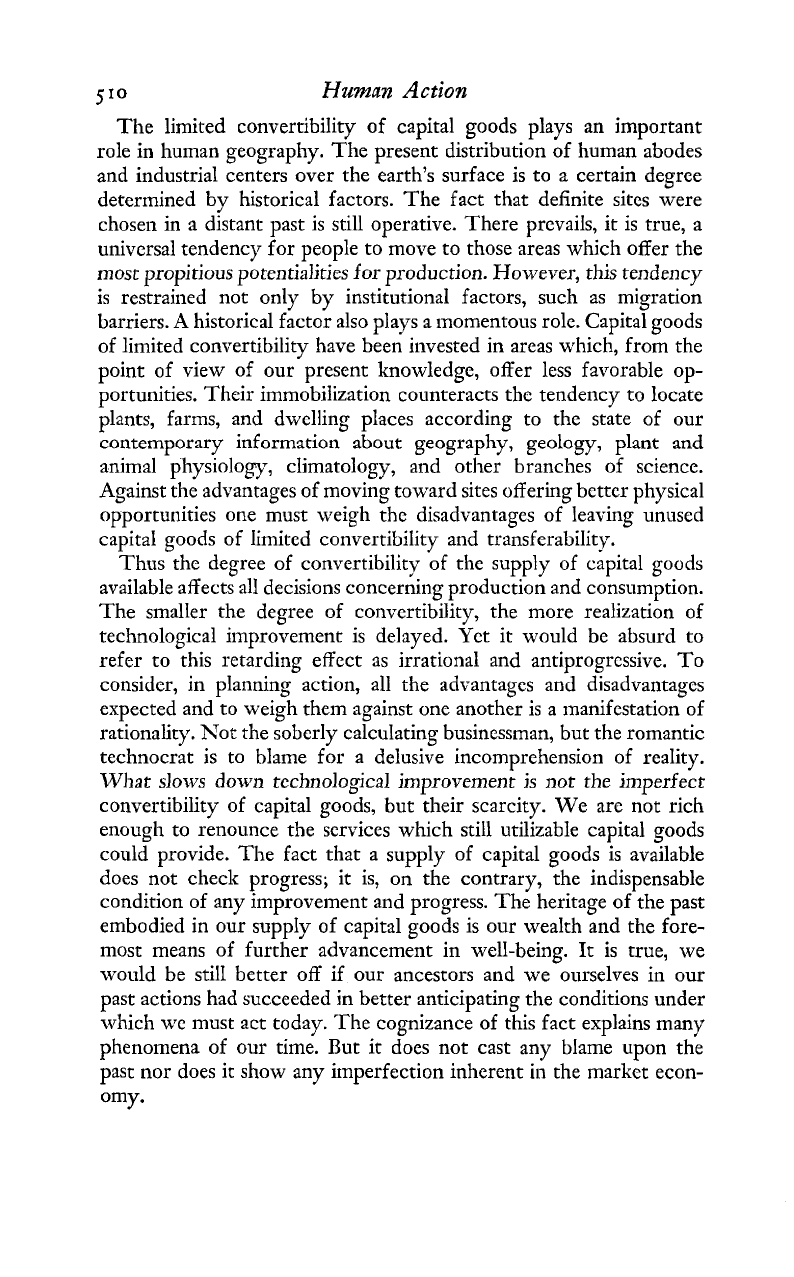
51°
Hman
Action
The limited convertibility of capital goods plays an important
role
in
human geography. The present distribution of human abodes
and industrial centers over the earth's surface is to a certain degree
determined by historical factors. The fact that definite sites were
chosen in a distant past is still operative. There prevails, it is true, a
universal tendency for people to move to those areas which offer the
most propitious potentialities for production. However, this tendency
is restrained not only by institutional factors, such as migration
barriers.
A
historical factor also plays a momentous role. Capital goods
of limited convertibility have been invested in areas which, from the
point of view of our present knowledge, offer less favorable op-
portunities. Their immobilization counteracts the tendency to locate
plants, farms, and dwelling places according to the state of our
contemporary information about geography, geology, plant and
animal physiology, climatology, and other branches of science.
Against the advantages of moving toward sites offering better physical
opportunities one must weigh the disadvantages of leaving unused
capital goods of limited convertibility and transferability.
Thus the degree of convertibility of the supply of cipital goods
available affects all decisions concerning production and consumption.
The smaller the degree of convertibility, the more realization of
technological improvement is delayed. Yet it would be absurd to
refer to this retarding effect as irrational and antiprogressive. To
consider, in planning action, all the advantages and disadvantages
expected and to weigh them against one another is a manifestation of
rationality. Not the soberly calculating businessman, but the romantic
technocrat is to blame for a delusive incomprehension of reality.
What
sloxvs down
technological
improvemenr is
not
the
imperfect
convertibility of capital goods, but their scarcity. We arc not rich
enough to renounce the services which still utilizable capital goods
could provide. The fact that a supply of capital goods is available
does not check progress; it is, on the contrary, the indispensable
condition of any improvement and progress. The heritage of the past
embodied in our suppIy of capital goods is our wealth and the fore-
most means of further advancement in well-being. It is true, we
would be stilI better off if our ancestors and we ourselves in our
past actions had succeeded in better anticipating the conditions under
which we must act today. The cognizance of this fact explains many
phenomena of our time. But it does not cast any blame upon the
past nor does it show any imperfection inherent in the market econ-
omy.
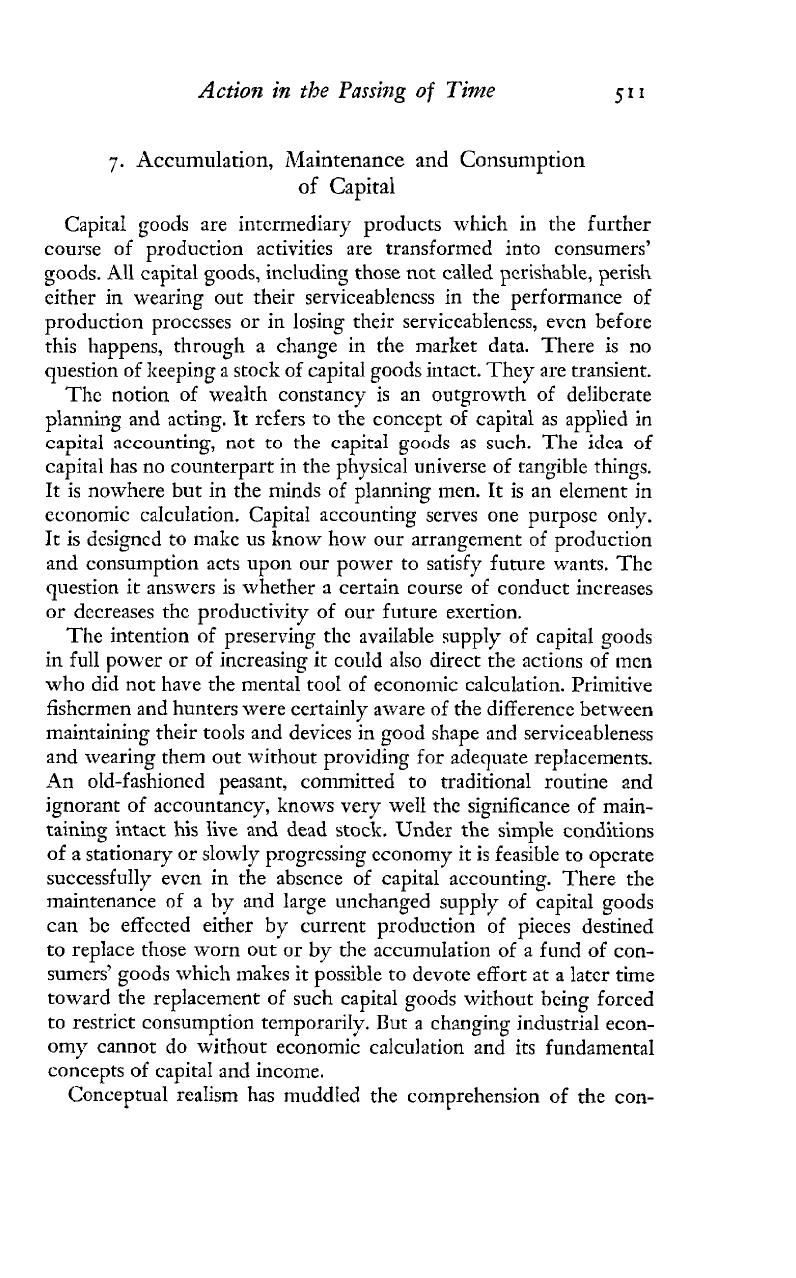
Action in the
Passing
of
Time
7.
Accumulation, Maintenance
and
Consumption
of
Capital
Capita1 goods are intcrmediary products which in the further
course of production activities are transforrncd into consumers'
goods.
All
capital goods, including those not called perishable, perish
cither in wearing out their serviceablencss in the performance of
production proccsses or in losing their serviceablencss, evcn before
this happens, through a change in the market data. There is no
question of keeping a stock of capital goods intact. They are transient.
The notion of wealth constancy is an outgrowth of deliberate
planning and acting.
It
refers to the concept of capital as applied
in
capital accounting, not to the capital goods as such. The idca of
capital has no counterpart in the physical universe of tangible things.
It is nowhcre but in the minds of planning mcn. It is an element in
economic calculation. Capita1 accounting serves one purpose only.
It
is dcsigncd to make us know how our arrangement of production
and consumption acts upon our power to satisfy future wants. The
question it answers is whether a certain course of conduct increases
or dccreases thc productivity of our future exertion.
The intention of preserving the avaiIable supply of capital goods
in full power or of increasing it could also direct the actions of men
who did not have the mental too1 of economic calculation. Primitive
fishcrmen and hunters were certainly aware
of
the difference between
maintaining their tools and devices in good shape and serviceableness
and wearing them out without providing for adequate
replacements.
An old-fashioned peasant, committed to traditional routine and
ignorant of accountancy, knows very we11 the significance of main-
taining intact his live
and
dead stock. Under the simple conditions
of
a
stationary or slowly progrcssing cconorny it is feasible to operate
successfully evcn in the abscnce of capital accounting. There the
maintcnance
of
a by and large u~~changed supply
of
capital goods
can be effccted either by currcnt production of pieces destined
to
replace those worn out or
by
the accumuIation of a fund of con-
sumcrs' goods which makes it possible to devote effort at a latcr time
toward the replacement of such capital goods without bcing forced
to restrict consumption temporarily. But a changing industrial econ-
omy cannot do without economic calculation and its fundamental
concepts of capita1 and income.
Conceptual realism has muddied the comprehension of the con-
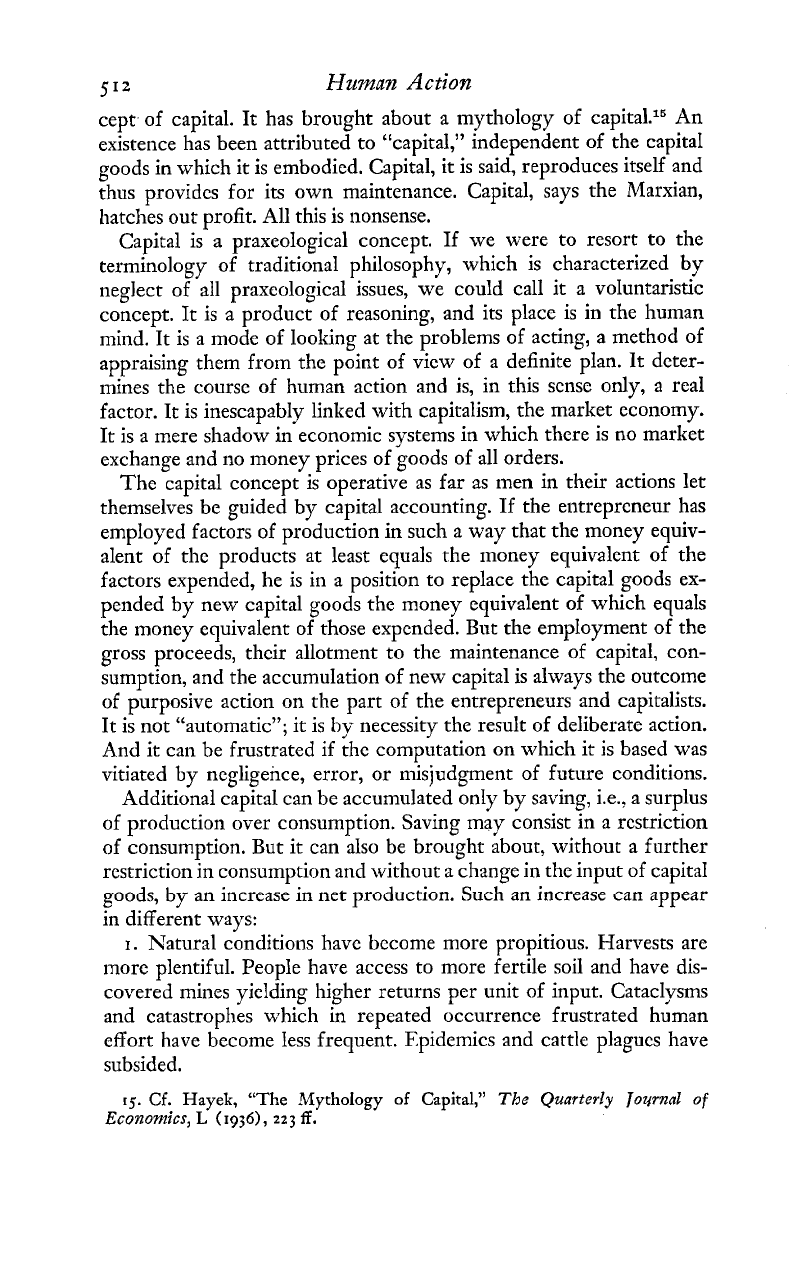
512
Human
Action
cept of capital. It has brought about a mythology of capital.15 An
existence has been attributed to "capital," independent of the capital
goods in which it is embodied. Capital, it is said, reproduces itself and
thus provides for its own maintenance. Capital, says the Marxian,
hatches out profit. All this is nonsense.
Capital is
a
praxeological concept. If we were to resort to the
terminology of traditional philosophy, which is characterized by
neglect of all praxeological issues, we could call it
a
voIuntaristic
concept. It is a product of reasoning, and its placc is in the human
mind. It is a mode of looking at the problems of acting,
a
method of
appraising them from the point of view of a definite plan. It dcter-
mines the course of human action and is, in this scnsc only, a real
factor. It is inescapably linked with capitalism, the market economy.
It is a mere shadow in economic systems in which there is no market
exchange and no money prices of goods of all orders.
The capital concept is operative as far as men in their actions let
themselves be guided by capital accounting. If the entrepreneur has
employed factors of production in such a way that the money equiv-
alent of the products at least equals the money equivalent of the
factors expended, he is in a position to replace the capital goods ex-
pended by new capital goods the money equivalent of which equals
the money equivalent of those expended. But the employment of the
gross proceeds, their allotment to the maintenance of capital, con-
sumption, and the accumulation of new capital is always the outcome
of purposive action on the part of the entrepreneurs and capitalists.
It is not "automatic"; it is by necessity the result of deliberate action.
And it can be frustrated if the computation on which it is based was
vitiated by negligence, error, or misjudgment of future conditions.
Additional capital can be accumulated only
by
saving, i.e.. a surplus
of production over consumption. Saving may consist in a restriction
of consumption. But it can also be brought about, without a further
restriction in consumption and without
a
change in the input of capita1
2-
L--
--
:
-------
:-
--.. ---A..-&:-- c
.-,.
L
--
----
"-
EUUU5,
UY
'dl1 IIILlCilSC Ill IICL ~JltJUULLIUII. L>ULII dl1 IllLlCd3C Ldll
d
PPdl
in different ways:
I.
hTatural conditions have become more propitious. Harvests are
more plentiful. People have access to more fertile soil and have dis-
covered mines yielding higher returns per unit of input. Cataclysms
and catastrophes which in repeated occurrence frustrated human
effort have become less frequent. Epidemics and cattle plagucs have
subsided.
'5.
Cf.
Hayek,
"The
Mythology
of
Capital,"
The
Quarterly
Joqmnl of
Economics,
L
(1936),
223
ff.

Action
in
the
Passing
of
Time
z.
People have succeeded in rendering some production processes
more fruitful without investing more capital goods
and
without
a
further
lengthening
of the period of production.
3.
institutional
disturbances of production activitics have become
lcss frccpent. The losses caused by war, rcvolutions, strikes, sabotage,
and other crimes have been reduced.
If the surpluses thus brought about arc employed as additional
investment, they further increase future net proceeds. Then it be-
comes possible to expand consumption without prejudice to the sup-
ply of capital goods available and the productivity of labor.
Capital is always accumulated by individuals or groups of individ-
uals acting in concert, nevcr by the Volkswirtschaft or the society.'"
It may happen that while some actors are accumulating additional
capital, others are at the same time consuming capital previously
accumulated. If these two processes are equal in amount, the sum
of the capital funds avajlabIe in the market system remains unaltered
and it is as if no change in the total amount of capital goods available
had occurred. The accumulation of additional capital on the part of
some people merely removes the necessity of shortening the period
of production of some processcs. But no further adoption of processes
with
a
longer period of production becomes feasible. If we look at
affairs from this angle wc may say that:
a
transfer of capital took place.
But one must guard oneself against confusing this notion of capital
transfer with the conveyance of property from one individual or
group of individuals to others.
The sale and purchase of capital goods and the loans granted to
business are not as such capita1 transfer. They are transactions which
are instrumental in conveying the concretc capital goods into the
hands of those entrepreneurs who want to employ them for the
performance of definite projects. They are only
ancillary
steps
in
the course of a long-range sequence of acts. lheir composite effect
decides the success or failure of the whole project. But neither profit
nor loss directly brings about either capita1 accumulation or capital
consumption.
It
is the
way
in which those in whose fortune profit
or loss occurs arrange their consumption that alters the amount of
capital available.
Capital transfer can be effected both without and with a convey-
ance in the owncrship of capital goods. The formcr is the casc when
one man consumes capital while another man independentlv ac-
cumulates capital in the same amount. The latter is the case if the
16.
The
state
and
the
municipaliries, in
the
market economy, are also merely
actors representing concerted action on the part
of
definite groups of individuals.
